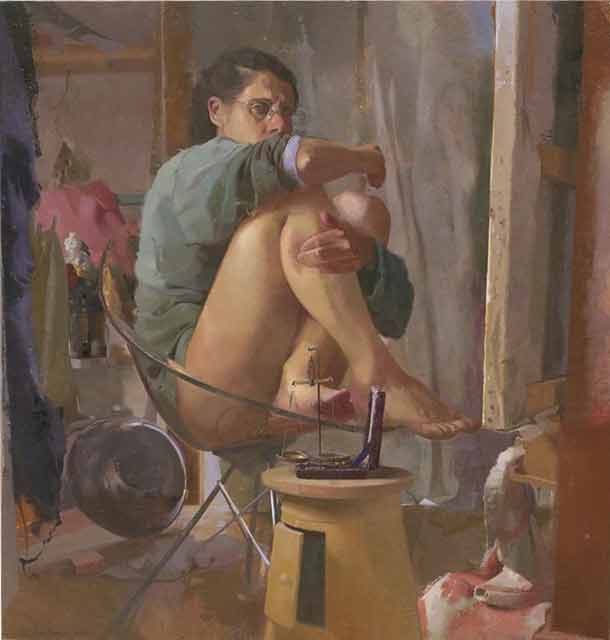
Sigal Tsabari , Hidden, 102.5x 102cm 2008-10 oil on canvas
click here for a much larger view (true for most all images)
This past summer, in Civita Castellana, Italy, I was fortunate to meet Sigal Tsabari and to watch her slide talk about her work. I was very pleased this summer when she agreed to an interview for Painting Perceptions.
I was moved by her simple, direct approach when talking about her work and life. Despite the fact English isn’t her native tongue, she was easily able to convey her intense commitment to serious painting. Hearing about how she grew her own vegetables from seed on her rooftop garden to then paint the progress of growth and eventual decay while still on the vine struck me as a powerful connection of painting to life, or as she puts it “I paint living nature”. Her observational painting makes a connection to us not just on a formal level but also in universal, human terms.
Sigal Tsabari lives in Rishon Le Zion, Israel She has shown work in both the Tel Aviv Museum and Israel Museum as well as the Golconda Fine Art gallery and the Rothschild Fine Art Gallery. Sigal teaches at the Jerusalem Studio School as well as the JSS summer program in Italy.
She will be having a one-person show at the Tel Aviv Museum in Spring 2013 as one of the two winners of the Haim Shiff Prize 2012.
This interview was conducted through Skype and email and I would like to express my gratitude in her taking so much of her time for this interview as well sharing so many images of her work.
Larry Groff: Can you tell us a little about your background and how you got into painting? You studied with Israel Hershberg in the late eighties. How has his teaching been influential to your work?
Sigal Tsabari : First I would like to thank you Larry for this opportunity to be one of the artists included in your blog. I’d like to share with your readers the way you asked me to be interviewed. It was on the stairs leading to the Morandi Museum after a long day in Bologna, and I was impressed by the directness and simplicity of the way you approached me.
I was born, Sigal Forkosh, in 1966 and grew up in Haifa, Israel. At the age of 10 with the encouragement of my mother I began to play the piano. 6 years later painting and playing the flute became a part of my life. I fell in love with the magical sound of the flute when I’ve heard my friend playing. In order to enhance my musical education I majored in art in high school. All at once I discovered a new world. I found an expression of myself in a non-verbal language. It left me hungry. I could paint for days from my imagination – the surrealistic painting of a teenager.
After high school I served 2 years in the army and than went to study in the Avni Institute of Art where I choose to study with Israel Hershberg as my main teacher as well as studying Printmaking there. At the age of 21, young, naïve and inexperienced I encountered the huge charisma of Israel Hershberg, the little that I knew of him and his work – I realized this is what I wanted. He brought with him from America what he learnt from his teachers (Edwin Dickinson, Lennart Anderson), in addition to helping train my eye, new ways to observe; he showed me the need for a profound commitment to painting as a way of life.
Grandma Malka-etude, 2007 oil on canvas, 48 x 30 cm
Hymn of weeds on the roof, 2006-8 oil on canvas, 126 x 104 cm
The Avni Institute was completely different from the fertile environment of the JSS today. It took me months to understand geometry, what is the meaning of a line as the end of a spot of color, how to ignore so many unneeded details in order to see the bigger, more important pictorial language; this was really difficult for me to understand at first. I remember having nightmarish dreams where I saw shapes, angles but slowly the lessons sank in.
Today I understand the advantage of coming in contact with Israel Hershberg when he was young and seeing his development as a painter over many years, I was a silent witness to his changes, preferences, and his relation to other painters. Eventually, Israel agreed to continue teaching us in one of the graduate’s home. In 1989 I became a mother – this was the greatest change in my life as a person.
During this period I played the flute in the Bat-Yam Orchestra (8 years). I started playing as second flute and later became the first flute, which fulfilled my musical ambition. I came to realize that playing in an orchestra also taught me painting! During rehearsals while listening to the different parts – musical phrases and individual instruments is like breaking down the score before your eyes or ears. Painting is analogous by its breaking down of forms, tonality and colors, and to understand why they are needed individually and bring them to synergy. That is a great lesson in painting. Today, I still continue to find a balance with this dialog within me between music and painting.
Origins of OR-a year later 1999-2000 oil on canvas, 99 x 63 cm
Expiration – Procreation, I 2004, Oil 22 x 22 cm
LG: Who or what have been the greatest influences on the work you do today?
ST: The short answer is everything and everyone surrounds me. Long answer…simple things such as my grandmother’s old towel that I keep in my studio, the soft young weeds growing after the first rain in my pots on my roof, the rotting eggplant at the end of summer, a simple comment by my daughter about a book on Caravaggio sitting on my table, and recently I read a quote by Lucian Freud quoting Degas quoting Ingres: “Muscles I know; they are my friends. But I have forgotten their names.”
In general, the dialog I have with the painters in my library comes in waves. I can’t say which painter influences me most, it’s more of a combination of painters that renews and changes over time. For instance, 10-12 years ago Avigdor Arikha was very central for me because of his immediacy—his vision of his immediate environment, his direct experience that becomes pictorial—and with his dialog with Mondrian. This in turn influenced me to get to know Mondrian’s work and I was amazed by his early works. Another influence of Arikha was his vast knowledge in the use of paper.
I have a vivid memory of the moment standing in San Francesco church in Arezzo in front of Piero’s fresco, the Legend of the True Cross, for the first time. The density of both the horses and soldiers legs, in their rich color and the rhythm of the greens beside the reds; the way it all worked together left me breathless.
Some of the other influences are all of Degas’s work, Vermeer, Ingres, the tenacity of Courbet, Lucian Freud, Isabella Quintanilla, Antonio Lopez Garcia, Leon Kossof’s book, Drawing from Painting, and recently; the drawings and lithographs of horses by Gericault.
The musical roof, 2006-8 oil on canvas 39.5 x 80.5 cm
Openings 2011 oil on canvas, 30 x 32cm
LG: Your painting and drawings appear to be intensely observed. Why is working in front of nature so important to you? What would be lacking if you were to paint solely from memory or photo reference?
ST: I believe that nature contains all the answers. By this I mean, when I put certain questions before nature, the answers come to me as vibrations.
LG: I’m not sure I understand what you mean by vibrations. Can you elaborate?
What I’m looking for in these vibrations is kind of a rhythm as in music. But in music when you play a piece of music you commit to the full phrase that you have to play, there is not just one bar or note to play. In painting of nature, of some visual experience, sometimes there is just one very small code for maybe one point – which has the vibration for the complete painting.
These vibrations are not informative—not how many solar collectors are on the third building in my current painting and not how small it is compared to another—but how much it exists, what is its musical place and what note it represents. And this experience I can only feel in nature especially because it isn’t stable, its ephemeral state.
No two days are alike and no two moments are the same, these changes help me to concentrate my focus more toward the inner depths of a subject rather than superficialities. When I come face to face with nature the visual facts expands my imagination to emphasize or deemphasize. A photograph doesn’t hold that tension for me. My work with printmaking makes use of drawings from nature and this process helps give me an even wider range of invention.
Morning, 2000 oil on canvas 22 x 22 cm
Okra II – Couple, 2001, oil on canvas 16 x 16 cm
Cocoon Convergence, 2007-8 oil on canvas 26 x 26 cm
LG: Is careful observation alone going to get that remarkable color and feeling of space, light, air and form we find in your paintings?
ST: Larry, I couldn’t answer this question if I didn’t try painting from a photo. Having tried because a lack of options. I participated in an Israeli TV program based on a BBC program Star Portraits- where we paint a celebrity over period of two weeks.(in this segment we painted Sheli Yechimovitz – the head of labor party). We had an initial and only live sitting of 5 hours of which the production and filming were the first priority. I completed the painting (90x70cm) from a photo over a period of two weeks – and I suffered from this experience. I felt barren- as if it was coming from the wrong source. To my surprise my painting was chosen but I realized more then ever that my painting should come from inner process and nourished from nature.
Another aspect of working from nature is the feeling of being swallowed by nature and I evaporate in it. Then I’m freed to discover and create my own order.
LG: I think I can see what you’re talking about here in your painting Cocoon Convergence, the invented order here is still based on intense observation. The female figure below the eggplant seems almost to evaporate when comparing its lightness to the palpable heaviness and solidity of the vegetables. They dwarf and almost threaten the figure with the emotional intensity of the forms. If I’m not mistaken, you need engage with the subject emotionally in order to truly lose yourself in this painted world. The intense observation is perhaps both a cause and effect of intense emotions.
Is there ever some point where you no longer still need the motif to be in front of you? Could you paint from just memory or invention? Or finish a painting from your imagination that you started from life?
No, I always need the observed motif because of the way I observe, the process of observation is endless. I find there is always more and more to be discovered in the motif. I’ve done paintings from imagination, especially when I was young but I find it closes my ability to analysis a piece of nature and to weave it into my canvas the bit of experience with the interaction with the nature. I need the nature to stretch my imagination, now I tell you that I can find in the canvas, the painting an imaginative interpretation of nature. I like and identify with what you said about “The intense observation being both a cause and effect of intense emotions”
Unlimited Cauliflowers, 2000 oil on canvas, 66 x 66 cm
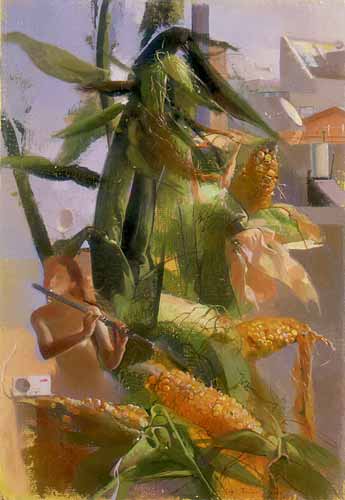
Syrinx II, 2004 oil on canvas 52.2 X 36.2 cm
LG: You usually work from observation however you don’t always paint everything at the same time or place, sometimes you appear to imaginatively collage subjects in the painting with different locations, scale and time-periods. For instance in your 2004 painting Syrinx – with the stages of the corn’s growth and the flutist. Can you tell us more about your process and thoughts here?
ST: My prime motivation arrives from nature, I feel myself a hunter, a witness and a servant- all three in the same breath. In the painting of Syrinx II I was impressed by how this corn grew with intensity like bamboo, without prior warning it sprouts a shoot of golden hair like a hair of nymph which develops daily within the closed husk, and the spiritual wind reveals itself.
When I observed the wind on it the mythological story of syrinx came to mind. (Syrinx was a nymph of Artemis. Pan fell in love with her and courted after her. She ran away from him and begged the river god for help; he turned her into a reed of bamboo. Pan picked the stalks in various lengths and the wind that passed through them produced different musical tones.)
I have been a flutist previously but after having set the flute aside – I felt an imperative to place myself in the painting as the flutist. After realizing the need to make these connections with the subject matter, I then turned to the decisions about balance, composition. Any lack of logic or perceptions of a collage are only esthetic and pictorial on this one level. At this point I tend to forget the narrative reason that I started with. Now the pictorial needs appear and take precedence, which I compare to a musical piece. In a musical piece there is a melody that expresses an idea, but develops independently. The melody is comprised basically of a line but also of tones—it is not all played Forte or Mezzo Piano or Pianissimo…this is the way I relate to the design of the canvas.
Planted, 2000 oil on canvas 121 x 85 cm
Reflection from Within, 2005 – 10, mixed technique on paper 100 x 140 cm
Anonymously, Haifa University, 2006, oil, pencil on paper 21 x 18 cm
LG: Many of your paintings, especially your garden subjects, focus attention on particular forms and areas of the painting while leaving other areas highly simplified or just a drawn outline. Can you share some thoughts about this approach? How do you decide what areas to bring to resolve and which to leave alone?
ST: In the beginning I’m a listener. Everything in the garden is beautiful, not all beauty is to be painted. In this state of passive listening I wait for something to move within me. When this happens I have a motif. From that moment on I remain with that impact that brought me to this motif. Then the natural changes remain within that impact. For example, when a new apple appears among dark leaves – as long as the apple remains in its surrounding light there is no difficulty to go with the change.
During this journey I consider what works and what doesn’t on the surface. Many times it doesn’t then I remove it and start again. This journey often involves an intimate striving to touch the higher moments in nature. When the impact reaches its fullest – then I stop, feeling that any further detail isn’t relevant. In fact the canvas tells me when it’s enough.
I’d like to mention that I learned much about myself when I started drawing horses. I challenged myself in drawing them knowing that it was bound to fail. Horses generally move more than eggplants…but I didn’t give up, I drew tens of charcoal drawings – all the same size, many never shown because they didn’t work. I discovered from the successful drawings that it doesn’t matter if a horse has 3 or 6 legs or 2 heads … what is important is that it has a code of precise structure, weight and light. This was a lesson!
A Place on the Arbel Cliff,2002-3, Oil, 96 x 48 cm
Umbilical Tie, 2002 oil on canvas 54 x 54 cm
Expiry and Shame- III 2004-5 oil on canvas, 45 x 20 cm
LG: Please tell us something about how you start your paintings both big and small. When you are planning for a large work that you’ll be spending a great deal of time what are some of the most important considerations you’ll consider before starting?
ST: My starting point is if it a big or a small painting is always one—which is that the idea for the painting interests me and I won’t become bored. Naturally the decision to work in a large format or tiny is made by the limitation of my daily life: weather conditions, motherhood, and teaching commitments… I don’t always have the ideal situation that allows me to choose.
In a small painting, if it’s a ‘premiere coup’, I wait for the ability to sing it in one phrase. When starting a large painting there is always a relationship between me and the reason. It begins with something that ripens within me over a long time. Like “Hidden”, for example, the introversion and withdrawal in a transparent chair, a kind of paradox—how can you hide in a clear plastic chair? Actually it’s a type of pyramid relating to a square, where different ellipses are revealed to the eye but not immediately.
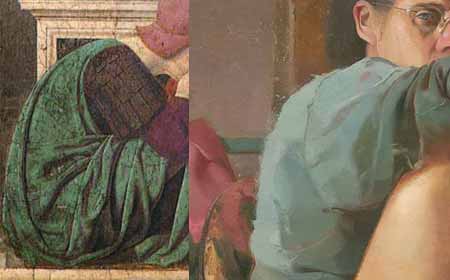
I was impressed by one of the soldiers (the left one) in “The Resurrection of Christ” by Piero Della Francesca – the presence of his posture – circular and diagonal movement at one in the same time. And the green garments with the red shading. This influenced in my selection of this shirt.
The relationship between the painting’s pictorial reasons and my personal reasons there are many moments of crises. Many times I don’t know where I’m going—because I never get locked into formulas. At this point I set aside the work and look at it for many hours, months, continue working on other paintings till a new idea arrives. I’ve learned over time that I have to be flexible with large works of what is needed even if it changes the original idea.
LG: There often seems to be an enigmatic narrative suggested in your work, especially the larger self-portraits. What can you tell us about meaning in your paintings? Can you talk about the non-verbal?
On your website there are articles written about your work one article by Mitai Mendelsohn “Facing the Real” stated that:
“Tsabari engages in a sort of pursuit after nature: she follows almost scientifically the development of plants growing in buckets on her balcony, depicting the changing hues of an eggplant and the enlarged shape of the okra fruit, which she doesn’t pick until the fruit dries off and hangs from the branch like a dead appendage. Such arrangements are often juxtaposed with images taken from her personal and family life. The growth of a plant serves as a metaphor for the growth of a person, or the growth of a child in the uterus. Themes of sexuality and motherhood comprise an important aspect of her work, as expressed in images of fertility and growth in nature.”
ST: Larry, this question is a logical continuation of the previous question. When I look at a painting—its important to me first to see and then to understand. The eye should perform the main task just as ear with music. If you can’t feel an experience in painting without an explanation something is defective. Therefore I don’t like to explain the meaning. Like most painters, the nonverbal dialog is about my place in the world but this is not the subject—only the catalysis.
I can often identify with situations like this in other painters. For instance, this Degas,pastel was a turning point in my work when I first saw it. What rang true with me was more the reason he painted it, not the subject matter. Years later I copied it keeping it as close as possible to the original, and from there a new variation arose. I prefer to leave the connections, meaning and interpretations for others to make—my mind is already too busy thinking about my next painting.
My paintings have this psychological aspect –it fills the drive, the need I have to paint, I’m not hiding this need, its open, – It’s all about questions, many questions about life; such as do I feel good in life?, do I feel bad, do I belong to something in this world, or do I feel isolated. These are questions that I do not get the answer but the way I deal with these questions with the way of the paint because painting is my best language. Much better than talking or writing and perhaps playing music speaks the same language for me. But I’m not sure it is needed to be explained. It’s up to you to decide. I’m not hiding that there’s no psychological aspect like maybe how Balthus would say (and hide about) about his young teenagers. I’m not hiding but I think that I say something about the way I relate when I explained my painting “Hidden” when I said “can you hide in a plastic transparent chair?” meaning can I hide? Can I be hidden in the world? I’m not trying to avoid the question.
I like to paint a very pure apple, pure eggplant – I paint it the same way I would paint my self-portrait with my tongue out. The way I relate psychologically to my self-portrait is the same way I relate to painting an eggplant. The narrative and the the psychological issues in the painting and painting such things as the light in the landscape – it is all the same for me.
I’m just a small person who doesn’t feel like I can tell someone how to look, I just give one option. I do have an interpretation for somethings but when I paint a very painful self-portrait, for instance, for me is the same as painting a very shiny eggplant, it’s the same.
Sketch, 2008 oil on wood 30.5 x 20 cm
LG: You taught a large group of students in the JSS Italy summer program in Civita Castellana last summer. How was the experience there for you? Will you be returning there next summer?
ST: This was my third year teaching in Italy—the first 2 years the program took place in Certosa di Pontignano, Siena, and this year in the amazing Civita Castellana. The experience was huge and my time there was greatly significant on many levels.
It is a great honor for me to teach. I meet a wide range of people in different ages with a passion to paint. Thanks to them – because by my explaining things to them I reinforce and gain a better understanding myself. I learn new ways of thinking and communicating, which idea and metaphors will speak best to them. The teaching process helps me in my own development. This is even more the case in Italy, where my students and I spent two intensive weeks together in ‘an artistic hothouse’. Normally the classes that I teach at the JSS, both adult and youth, meet just once a week. But in Italy we start our day, eat, go out to work, travel to our weekly trips, and support each other in difficult moments, laugh – and live painting together.
Something unexplained in the light in Italy, I find myself observing for hours – not only because of the beauty that strikes my eyes, but the presence of the old masters on each cliff, in every shadow, on the laundry hanging from the window – it is to big to take it in. I find myself digesting the experience throughout the year till the next summer. Last summer’s group was very heterogeneous as far as culture, language, background in art experience and this difference brought with it a special interaction and unique togetherness. I learned that the passion for painting overcome all differences. It was difficult to say goodbye.
My teaching experience has taught me that there are no two groups or years similar to each other. Another aspect during the summer program is the interaction with the JSS master class, the affiliate groups and guests artists which enhances the overall experience greatly. This is a fertile field… My program for next summer is all laid out and ready to go.
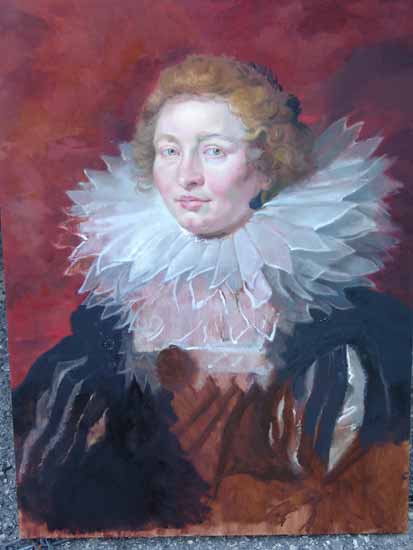
copy of the Portrait of Madame de Vicq by Rubens from the Tel Aviv museum
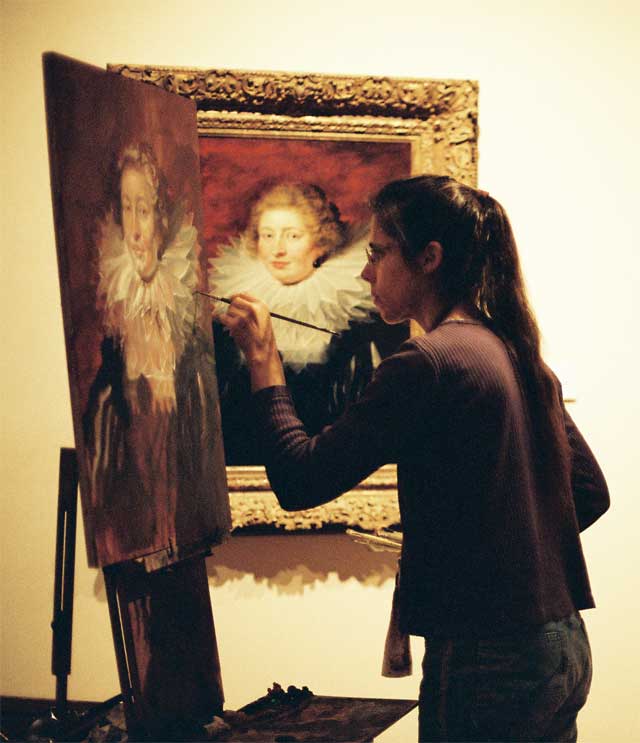
photo by Eran Ackerman
photo by Eran Ackerman
LG: I understand you’ve been copying a Rubens in the Tel Aviv museum. What led you to do this at this time? How does copying a masterwork like this speak to your own work?
ST: My education has not been chronological because of circumstances. I felt the need to stand in front of a masterpiece and copy, or to say it more correctly- to follow Rubens’s process this truly interested me. To put my ego aside, and stand looking over Rubens’s shoulder and observe him working.
Starting with the preparation of the panel, ground and imprimatura, and his indirect painting. I read and researched about his technique, I even traveled to London to see his unfinished paintings. In the Louvre I met the complementary pair of paintings, Madame de Vicq and her husband Henri De Vicq. I studied how his use of glazing achieves transparency and how his use of complementary colors creates tension and depth instead of tonality. Rubens was right handed and I tried to stay with his brush strokes being left handed.
In Tel Aviv museum I found the Rubens portrait of Madame de Vicq to be the most suitable for me. I haven’t yet completed this project. I invited my friend Eran Ackerman, a photographer, to document my process of copying this painting. Through this collaboration we both learned of the similarities and differences between photography and painting. I’d like to thank Eran for his great efforts and friendship.
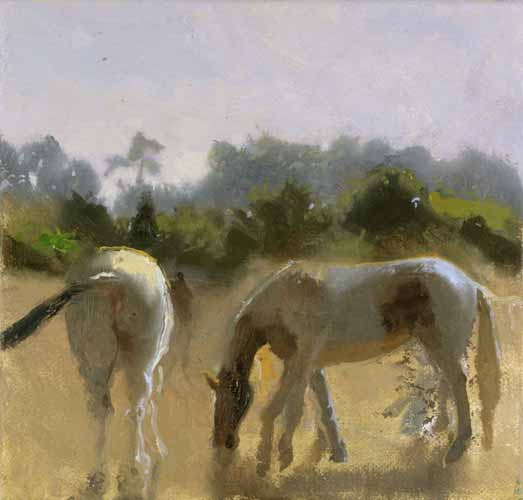
Each One for Herself 2006 oil on canvas 14.5 x 15.5
LG: You have been working on an edition at the Jerusalem Print workshop. Some of your prints, especially of the horses, seem to grow out of the intense drawing of horses you’ve done from observation. Can you tell us something about the role of printmaking in your art-making? Has working from drawings in your printmaking influenced the direction for your painting?
ST: It has been my privilege to be invited as an artist to work on an edition at the Jerusalem Print Workshop. Sidon Rothenberg, master printer and Arik Kilemnik, master printer and founder and director of the workshop, have both provided valuble instruction and work with me step by step sharing their rich experience.
At first, this unfamiliar beginning of the printmaking process left me immobilized. All the tools that I knew from painting or long pencil drawings do not exist in printing. I realized I had to change my way of thinking. It would be wrong to treat the printing plate as it was a canvas. There were many discoveries about the differences and what is correct for the plate and it’s various techniques.
The drawings of horses were perfect for this purpose, having been observed, quickly and open as opposed to etching which is slow and precise. From these edges I invent, and invention rests on printing perception. I’m still very close to this process, I feel the influence on my painting—it’s stretching of my ability—but it is still not the right time for me to verbalize it.
NOTE: All prints published and printed by the Jerusalem Print Workshop

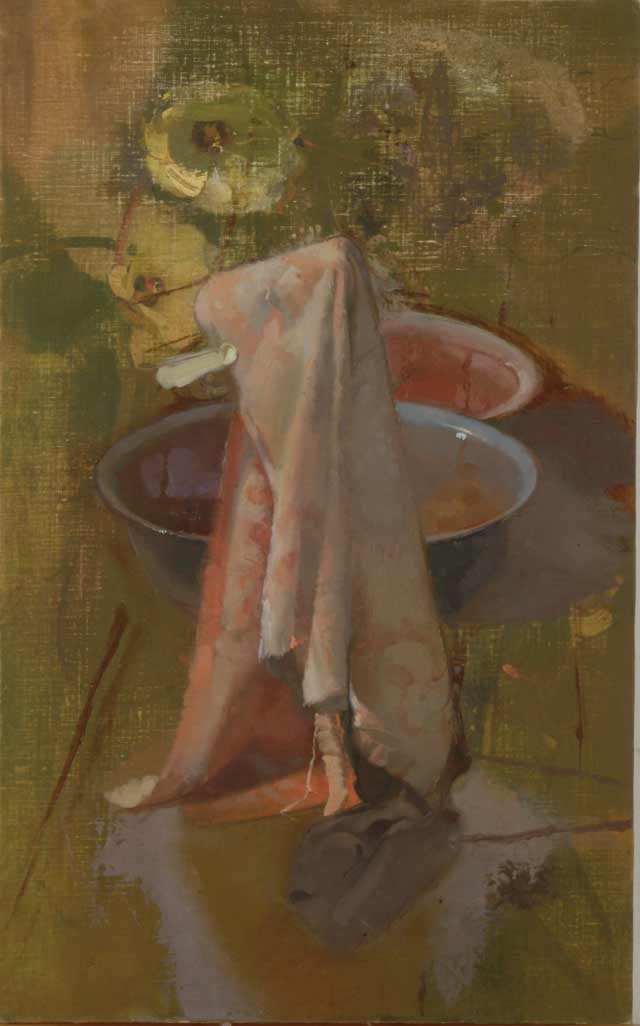
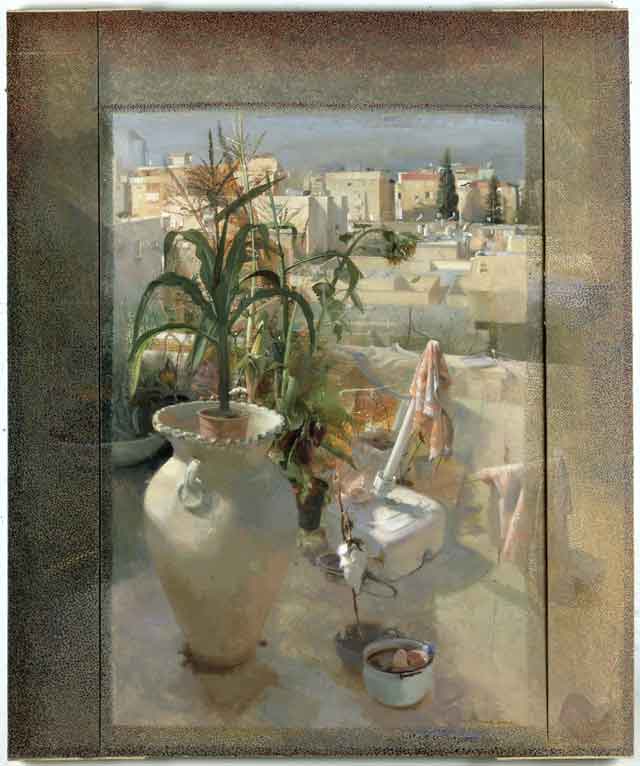
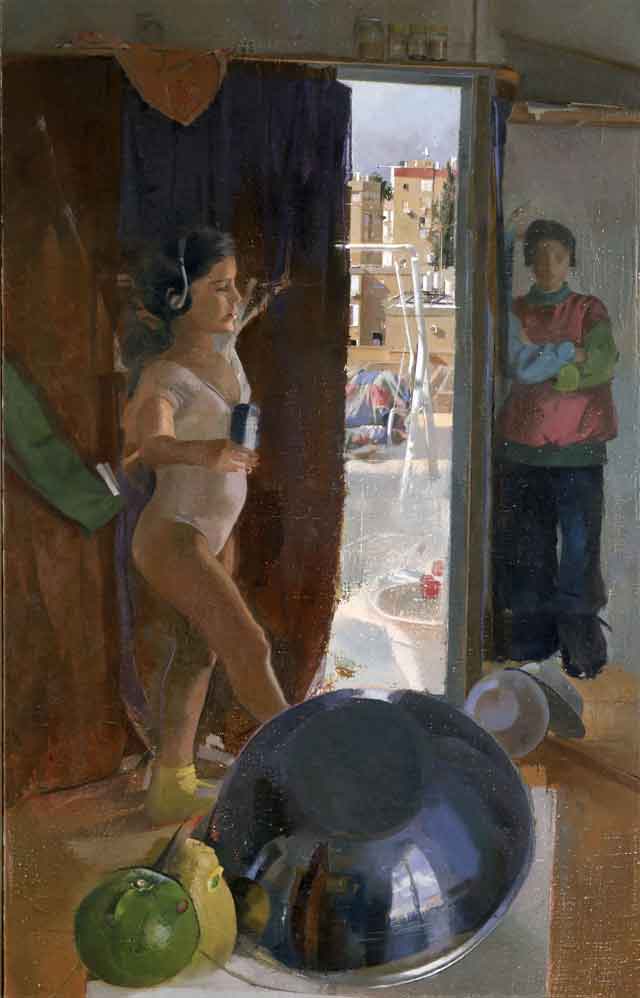
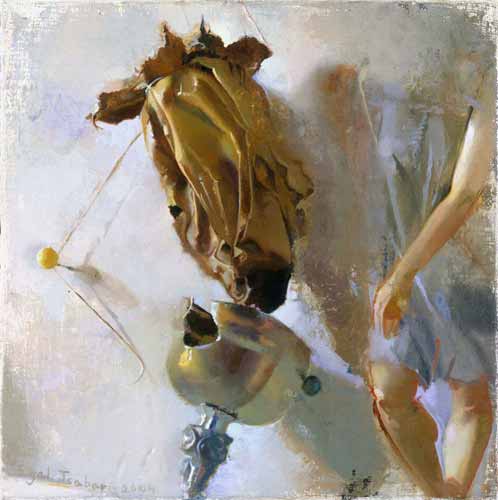
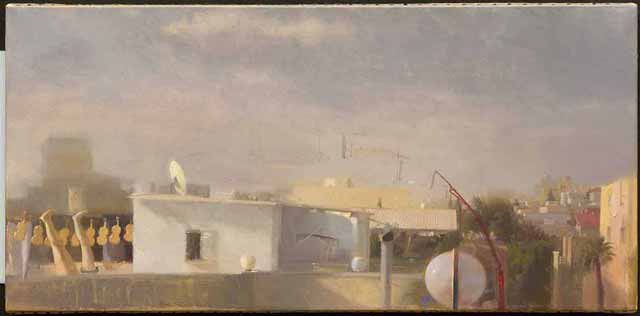
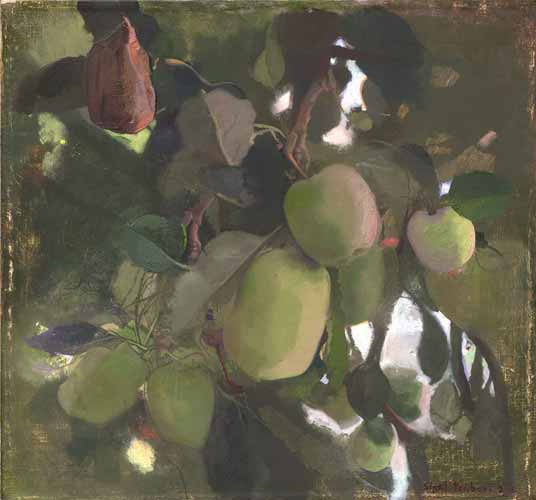
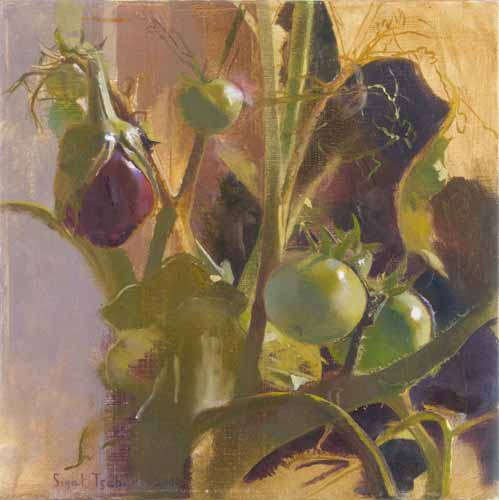

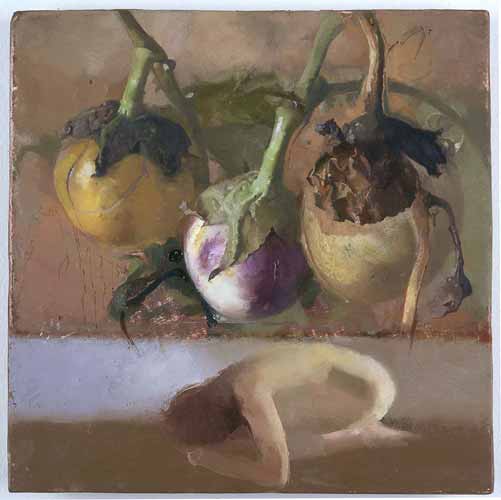
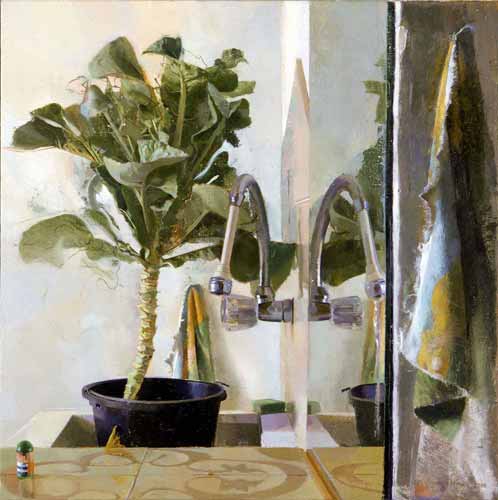
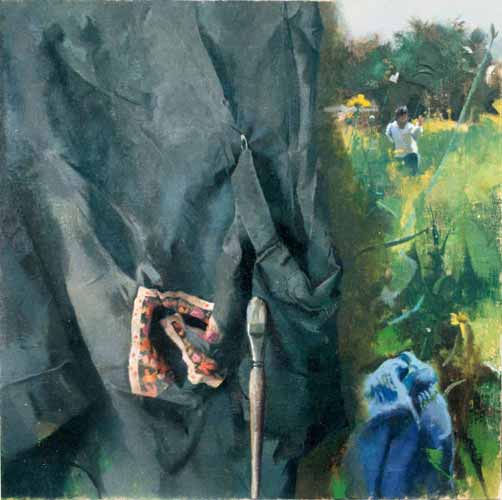
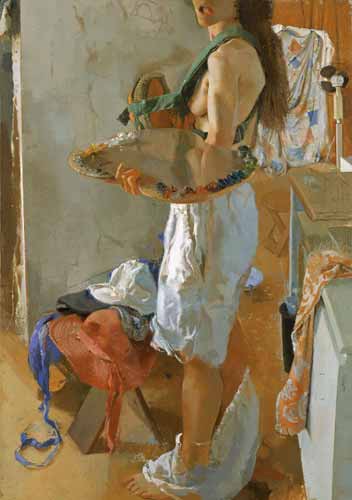

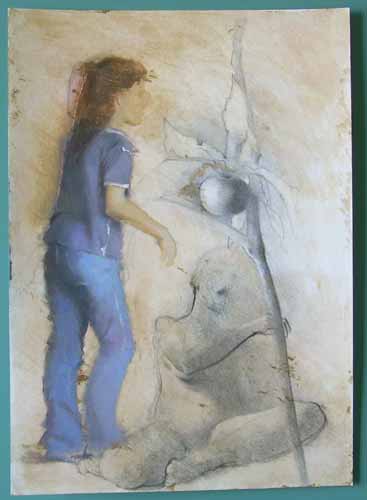
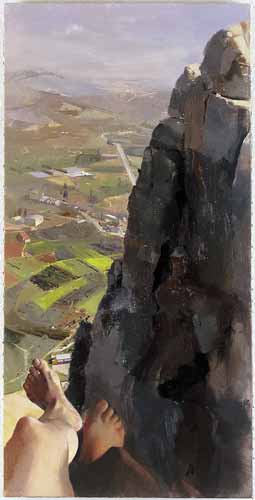
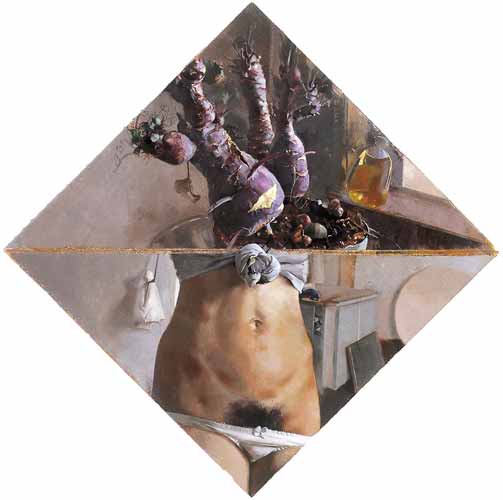
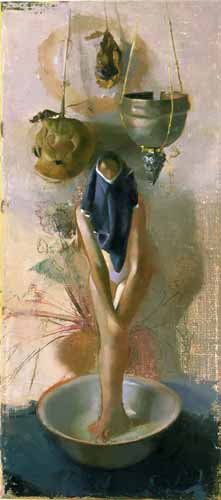
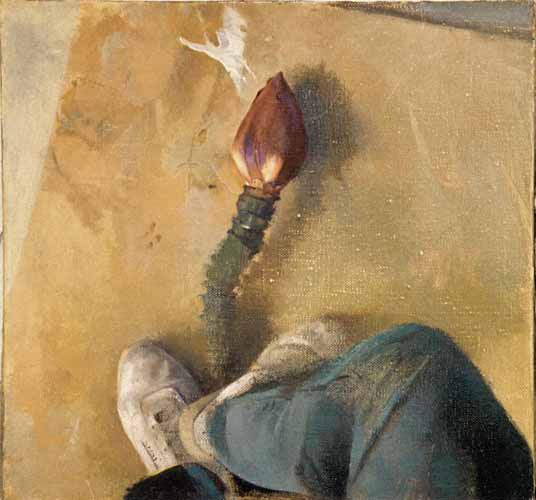
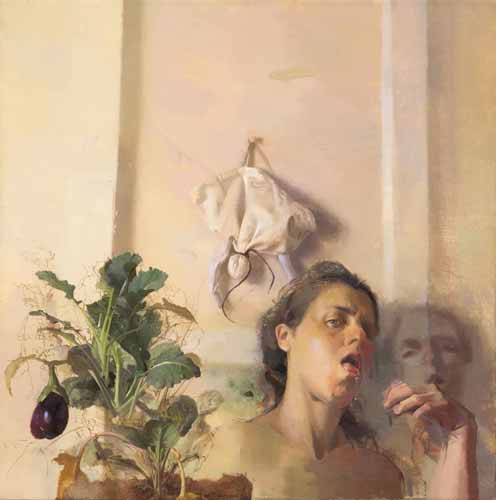
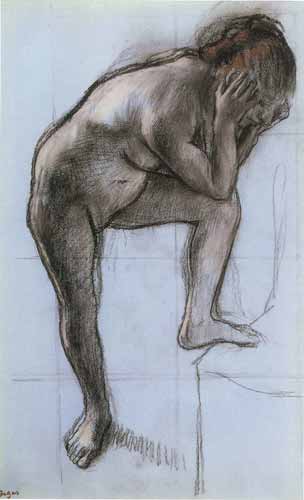
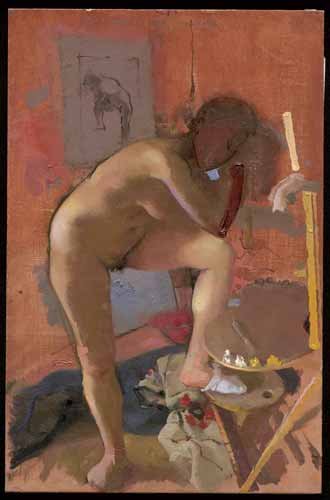
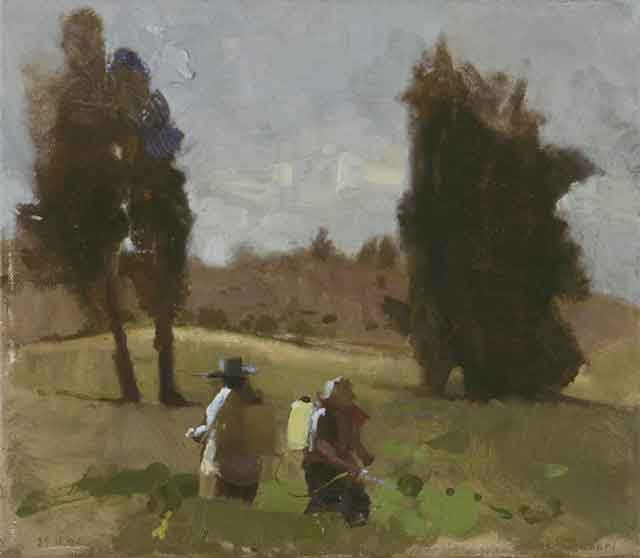
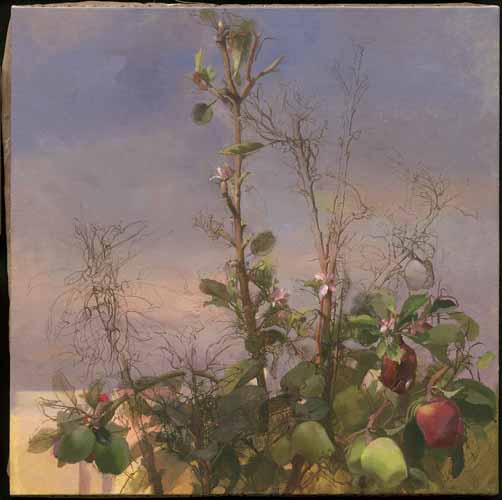
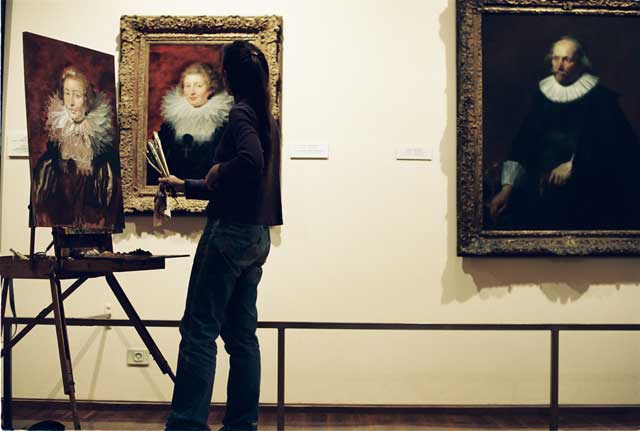
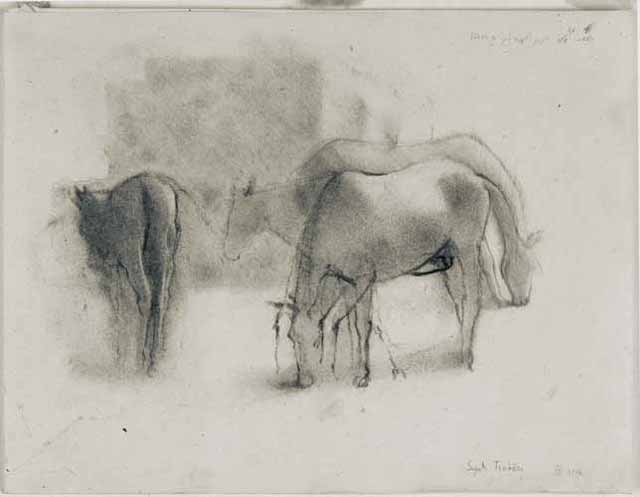
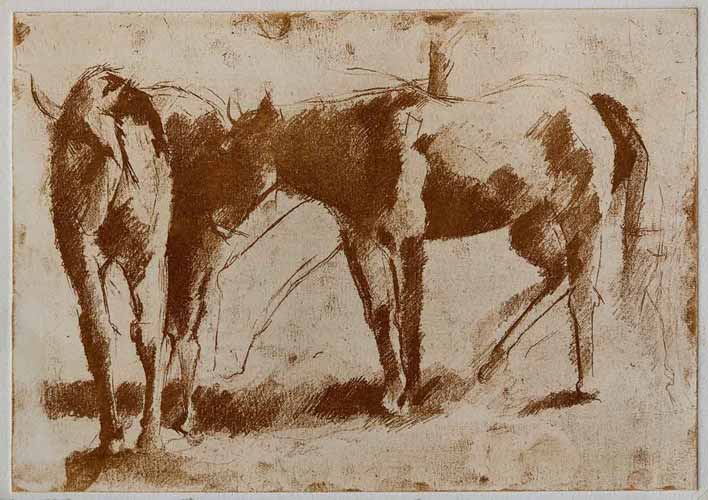
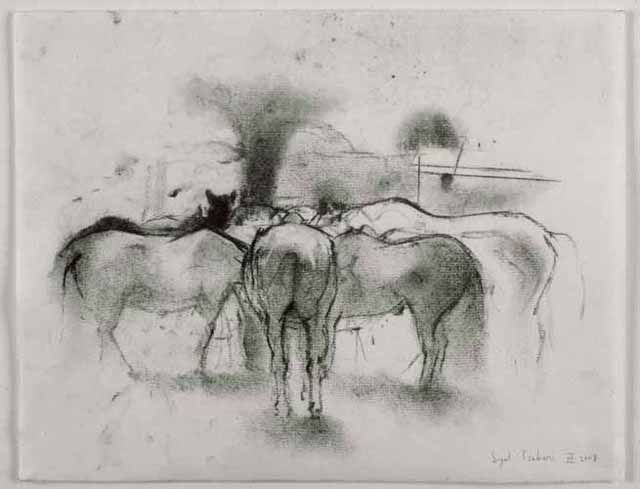
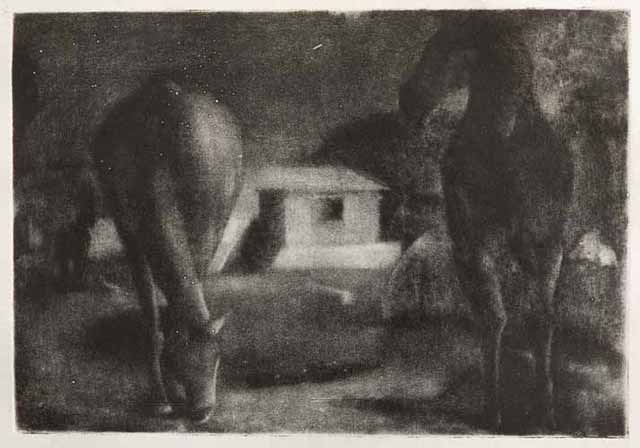
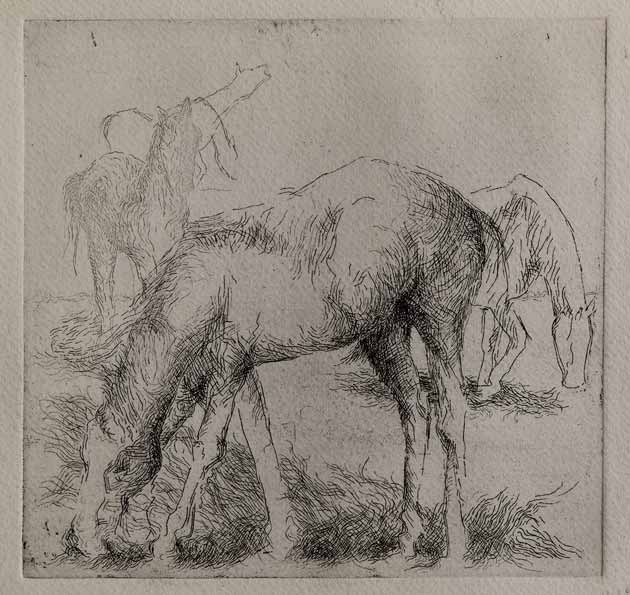




Great Interview!
I studied with Sigal for several years- she is an incredibly committed teacher. I was excited to learn that she will be having a solo exhibit in the spring of 2013 🙂
Sigal is an amazing and inspiring artist.
It’s wonderful to see such beautiful, human works and to hear about her creative process. She has mastered her craft and is intimately in touch with her inner artistic impulses. Thanks so much Larry and Sigal for this energizing interview!
Great painter and a wonderful interview. I’ve been looking at Sigal’s work for a few years now, unfortunately only online.
I wish I could see them in person as she has a great sensibility and outlook in painting that I really relate too.
Very original work all around.
This is very beautiful painting. With “Unlimited Cauliflowers” and it’s space-time shift between whats happening in the mirror and whats being reflected…also the cloth on the right hand margin (is that a close up or a re-imagined view of the same fabric behind the plant?) What a delight to view this artist’s work. The integrity of her paint handling and thoughts shine through in the interview and images. It’s a real testament to the school of artists involved with realism in Israel right now, and all the great painting and ideas that come out of the JSS. What a treat…I hope to visit some day soon!
She is a very talented artist, very professional, clean lines, clear sketch. However, judging by the choice of subjects, she is drawn towards an arrangement of mixed up messy cloths, clothes and nude. Some strange obsession with eggplants too… Not my cup of tea. Some still lifes are nice though… And the horses.
“Create a Teacher for yourself, get yourself a Friend, and stay positive in your opinions about People” (Pirkei Avot, Chapter 1, article 6)
I joined the Jerusalem School of painting for the marathon 2010, having main purpose of finding the teacher. At that stage I did not see works of Sigal Tzabari, and selected her intuitively, seeing how serious, objective and demanding she is with her students.
Circumstances forced me to delay starting the course, and eventually I started it only two years after, during the year 2012. Six months after I finally managed to see her works, and made myself familiar with her biography. I must say that I am so happy that I trusted my intuition, and was not mistaken in selected her as a teacher.
Works of Sigal are full of life and humor; they show real Israel, there are real and clearly recognized. At the same time these works are fresh, unpredictable, personal, and demonstrate own female world, painted by professional male hand. Sigal chants reach fertility and wet sensuality with strong yet restrained graphical means, characterized by preciseness, professionalism, careful observation, wealth of palette, combined with the modesty.
Her graphic works are compelling and full of tension, and force the viewer to stay connected and engaged. There works make you watching them, travelling on and with them; just like a magnet they pull viewer in, and do not let him go.
Paintings of Sigal really impressed me. I have not received such a pleasure for very long time, and really look forward to enjoy her forthcoming exhibition.
Ela Balaklav. architect.
I studied with Sigal, the very devoted and talented teacher. I think she is one of the best, of all the art teachers that I had. The interview is very emotional, deep and extensive and shed many different lights on Sigal’s personality and art experience. It is the first time I see such a wide collection of Sigal’s works of art. The way the combination of different objects and plants together with human beings, in a single art-work, is especially interesting and inspiring, unique and very well carried out. [As a biologist, I can judge that the horses and plants are very well express the realistic beauty of life].
We look forward for the exhibition of Sigal at the Tel-Aviv Art Museum, later this year.
Thank you Larry and Sigal Tsabari for such an inspiring interview. What a wonderful combination of emotional honesty and structural complexity in these compositions. Ms. Tsabari’s palette is so subtle in tonal nuance and is balanced by the carefully placed touches of more intense hue. I love these paintings.
Beautiful work!
Very interesting. Thanks, Larry. The work reminds me a bit of what I like about Balthus- heartfelt (if disconcerting), certainly a distinct voice.
I really enjoyed this interview, and discovering Sigal Tsabari, and Isreal Hershbeg artwork. Inspiring, thank you!
It is rare that an artist combines exquisite drawing ability, color and design together in one package. Usually artists are known for just one. Her paint handling is beautiful without being superficial and slick.
Beautiful.